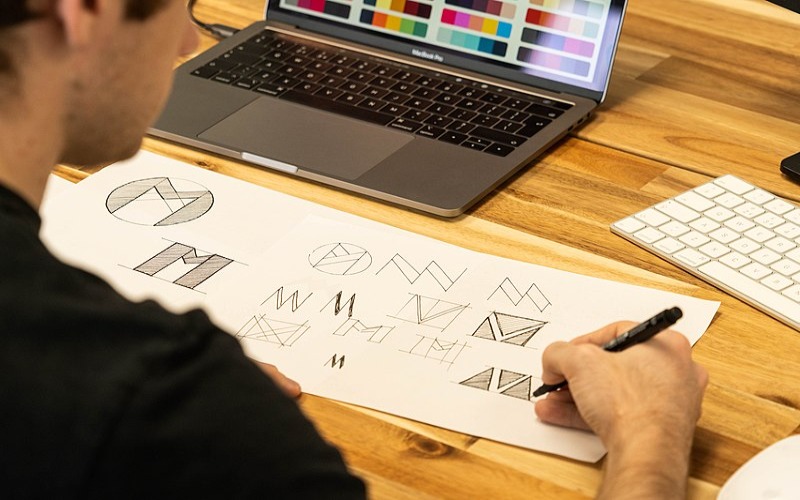In the ever-evolving world of graphic design, the tidal wave of AI innovation is reshaping the landscape at an unprecedented pace. Imagine, for a moment, a tool that can conceptualize and generate complex designs in mere seconds, a feat that once took hours or days. This is no longer the realm of science fiction. AI-driven design tools are not just augmenting human creativity; they’re revolutionizing it. They’re enabling designers to explore uncharted creative territories, transforming vague ideas into concrete visuals almost instantaneously.
Take, for instance, AI-powered logo generators. These tools, through a blend of machine learning algorithms and design principles, can churn out a plethora of logo options tailored to specific brand identities. This isn’t just about saving time; it’s about opening up a galaxy of creative possibilities that might have otherwise remained unexplored. The balance, however, is delicate. As we embrace these AI tools, the role of the designer is evolving from creator to curator, sifting through AI-generated options to find the perfect fit.
The Digital Canvas Expands: VR and AR in Design
Virtual and augmented reality are not just for gamers and tech enthusiasts anymore; they’re becoming essential tools for graphic designers. Imagine donning a VR headset and stepping into your design, walking around it, and experiencing it in a 3D space. This isn’t a futuristic dream but a present reality. Tools like Adobe’s Aero are already making AR more accessible to designers, enabling them to craft immersive experiences from their desktops.
In the realm of VR, applications like Gravity Sketch allow designers to literally ‘draw’ in a three-dimensional space, turning the air around them into a canvas. This technology is not just a new medium; it’s a new language of design. It’s about breaking free from the constraints of the two-dimensional screen and exploring a whole new world of possibilities.
Harnessing the Power of Haptic Feedback
The buzz around haptic feedback technology is growing louder, and for good reason. This tech, which simulates the sense of touch through vibrations and motions, is opening up new frontiers in graphic design. Imagine a digital pen that can mimic the feel of different textures, giving designers a more tactile experience as they create. It’s not just about seeing the design; it’s about feeling it.
This technology isn’t just a novelty; it’s a tool that can greatly enhance the design process. By simulating the physical interaction with materials, haptic feedback adds a layer of depth and realism to digital creation, bridging the gap between the physical and digital worlds.
Integrating AI-Powered Background Removal
Amid these groundbreaking advancements, there’s a growing need for tools that simplify the design process. Enter the realm of AI-powered background removal, a feature that has become indispensable for graphic designers. It’s about cutting down on the tedious, time-consuming tasks, freeing up creatives to focus on the bigger picture.
In this context, the free background remover by Vista stands out. This tool seamlessly extracts subjects from their backgrounds, providing a clean slate for further creative exploration. It’s not just about removing backgrounds; it’s about setting the stage for creativity. VistaCreate’s tool exemplifies how AI can streamline the design process, allowing designers to execute their visions more efficiently and effectively.
The Sustainability Factor in Design Tech
As we marvel at these technological advancements, there’s a growing conversation around sustainability in graphic design. How do we leverage these technologies in a way that’s mindful of our environmental footprint? The answer lies in both the materials we use and the way we design. For instance, eco-friendly inks and recycled materials are becoming increasingly prevalent in physical designs.
But sustainability in design goes beyond materials; it’s also about efficiency and longevity. Technologies that enable more precise, efficient designs help reduce waste, whether it’s in the form of physical materials or digital resources. As designers, our responsibility extends beyond the canvas; it encompasses the world that canvas exists within.
Embracing the Ethical Dimensions of Design Tech
With great power comes great responsibility, and this adage holds in the realm of graphic design technology. The ethical implications of these technologies cannot be overlooked. As AI and VR become more prevalent, questions arise about authenticity, originality, and the role of the human designer.
It’s a dialogue that needs to happen within the design community. How do we ensure that AI aids creativity rather than replaces it? How do we maintain a human touch in a digitally dominated world? These are not just philosophical questions; they’re practical ones, guiding the future trajectory of graphic design. As we navigate these waters, the focus must remain on using technology as a tool to enhance human creativity, not replace it.
Final Thoughts
As we stand at the crossroads of technological innovation and creative expression, the future of graphic design is not just about embracing new tools; it’s about reimagining our relationship with them. The convergence of AI, VR, AR, and other emerging technologies is not just transforming how we design; it’s reshaping what it means to be a designer. The key lies in harnessing these tools to amplify our creative instincts, not to overshadow them. In this rapidly evolving landscape, the role of the designer is more vital than ever – as a visionary, a strategist, and a storyteller.
Looking ahead, the most exciting aspect of these advancements is their potential to democratize design, making it more accessible and inclusive. With tools like AI-powered background removers and intuitive VR interfaces, the barriers to entering the world of graphic design are lower than ever. This accessibility promises a future where a more diverse array of voices and visions contribute to the tapestry of visual culture. As we navigate this new era, our challenge and opportunity as designers are to meld these technological wonders with the irreplaceable nuances of human creativity, charting a course toward a future that is as responsible and sustainable as it is innovative and inspiring.










